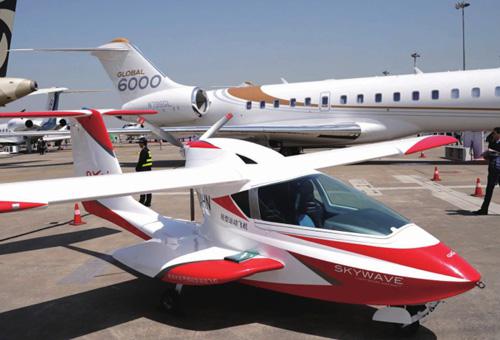Signs of Recovery Inspire Business Aviation Industry
With global players gearing up to boost their presence in the market, China has been seeing signs of recovery in its business aviation industry.
“More frequent business activities stimulate the buying of business aircraft or the use of charter services thanks to the countrys economic growth,” said Jenny Lau, Chairperson of the Asian Business Aviation Association (ASBAA).
“Healthier and more rational development in the industry is on track following multiple years of slowing growth beginning in 2013, after the previous round of market expansion.”
Lau made the remarks at the 2018 Asian Business Aviation Conference and Exhibition(ABACE), the largest annual business aviation expo in Asia, which runs from April 17 to 19 in Shanghai.
ABACE 2018 attracted 170 exhibitors, including almost all of the worlds major business aircraft manufacturers with 30 of their fl agship models.
Related companies also participated, seeking business opportunities from the high-value industrial chain such as systems supply, maintenance, leasing and chartering.
Last year, China operated 330 jet and 250 turboprop business aircraft that supported business travel, law enforcement and humanitarian needs, according to the ASBAA.
A recent survey showed that 61 percent of industry insiders noted aircraft utilization had increased 42 percent since the fourth quarter of 2015.
For Gulfstream, a leading global aircraft manufacturer, the Asia-Pacific region continues to be its largest market, said Scott Neal, Gulfstream Senior Vice President for Worldwide Sales.
In China, Gulfstreams fleet has grown almost 70 percent since 2013, with 197 Gulfstream aircraft serving China.
“While the frenetic pace of activity weve seen over the past several years has tempered, were seeing initial signs of potential uptick in activity,” said Neal.
Deliveries continued as its fleet in the region grew by almost 6 percent in 2017.
“We see a market evolution in Chinas business aviation and forecast a positive outlook for its continued growth,” said Andy Gill, Senior Director of Business and General Aviation in Asia-Pacifi c for Honeywell Aerospace.
“Surveys indicate that Chinese customers show stronger brand preference. Long- range aircraft with large cabins remain the best sellers, while more medium and light business aircraft are joining the market for private owners and charter companies,” Gill said.
Boeing Business Jet (BBJ) is also seeing more demand for its ultra-large business jets as Chinese operators travel with larger teams and travel farther, said BBJ President Gregory E. Laxton.
Thirty BBJ aircraft operate in China and the company is confident in the markets future.
“We believe that the Chinese economy will continue to grow and prosper,” said Laxton.
Japans Honda Aircraft Company brought the HondaJet, a light business jet to ABACE 2018, to tap into the Chinese market.
“Young entrepreneurs are more aggressively using efficient and comfortable vehicles and services,” said Honda Aircraft President and CEO Dr. Michimasa Fujino.
He added that Honda had received eight orders from the Chinese market in the past six months from private buyers and charter operators.
Thanks to Chinas economic growth, newly wealthy entrepreneurs want more efficient, convenient and comfortable transport.
“The essence of business aircraft as effi cient transportation is being acknowledged more and more by Chinese entrepreneurs, whose footprint and businesses are extending worldwide,” Lau said.
The Chinese Government is determined to foster the growth of the general aviation industry, including business aviation, by building 200 new general airports and further opening its low altitude airspace.
“China is a young, but very promising market,” said Benoit Defforge, President of Airbus Corporate Jets (ACJ).
To better support emerging business aircraft owners and operators, ACJ has launched a financial support scheme, with some services tailored to Chinese customers.
“We are positive about the Chinese market due to the value of our business aircraft,”Defforge said.

